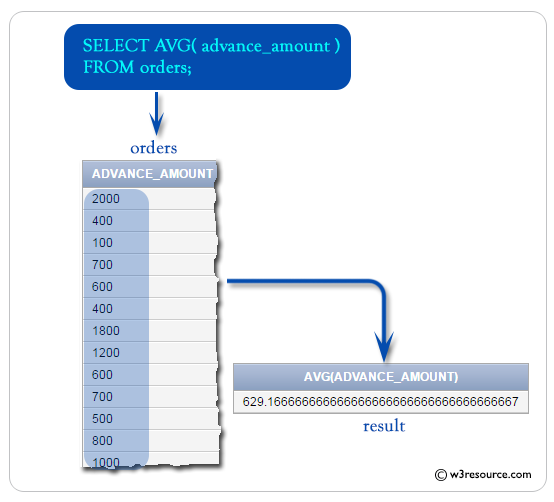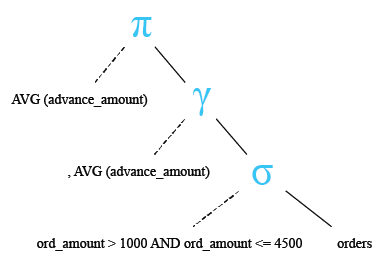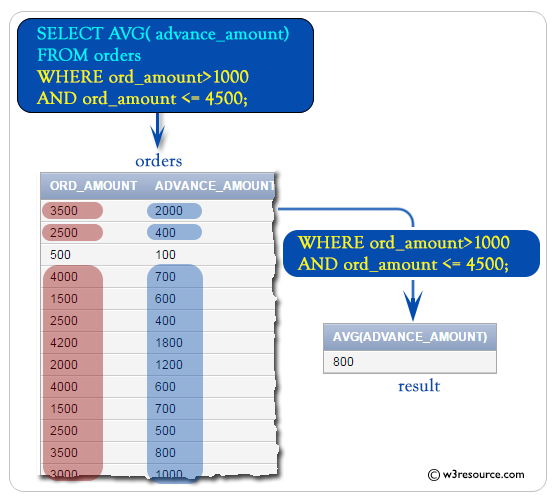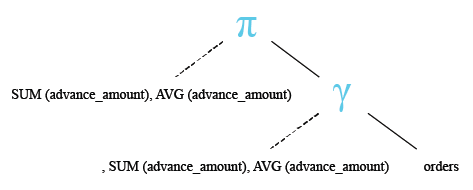SQL AVG() function
AVG() function
SQL AVG() function calculates the average value of a column of numeric type. It returns the average of all non NULL values
Syntax:
AVG ([ALL | DISTINCT] expression )
DBMS Support: COUNT() function
| DBMS | Command |
| MySQL | Supported |
| PostgreSQL | Supported |
| SQL Server | Supported |
| Oracle | Supported |
DB2 and Oracle Syntax:
AVG ([ALL | DISTINCT] expression ) OVER (window_clause)
Parameters:
| Name | Description |
|---|---|
| ALL | Applies to all values. |
| DISTINCT | Return the sum of unique values. |
| expression | Expression made up of a single constant, variable, scalar function, or column name. The expression is an expression of the exact numeric or approximate numeric data type category, except for the bit data type. Aggregate functions and subqueries are not permitted. |
Syntax diagram - AVERAGE() function

Example:
To get the data the average of 'advance_amount' from the 'orders' table, the following SQL statement can be used :
SELECT AVG( advance_amount )
FROM orders;Sample table: orders
Output:
AVG(ADVANCE_AMOUNT)
-------------------
629.166667
Pictorial Presentation:

SQL AVG() with null
To get the data of 'agent_code', sum of 'opening_amt', number of customer for each agent, and 'receive_amt' from the 'customer' table, the following SQL statement can be used :
SELECT agent_code, SUM (opening_amt),
COUNT(*), ROUND(SUM (opening_amt) /COUNT(*)) AS MYAVG,
ROUND(AVG (opening_amt)) AS SQLAVG
FROM customer
GROUP BY agent_code;Sample table : customer
Output:
AGENT_CODE SUM(OPENING_AMT) COUNT(*) MYAVG SQLAVG ---------- ---------------- ---------- ---------- ---------- A002 22000 3 7333 7333 A004 25000 3 8333 8333 A007 16000 2 8000 8000 A009 6000 1 6000 6000 A011 5000 1 5000 5000 A012 5000 1 5000 5000 A010 22000 3 7333 7333 A001 8000 1 8000 8000 A008 13000 3 4333 4333 A006 8000 2 4000 4000 A005 19000 3 6333 6333 A003 12000 2 6000 6000
SQL AVG() with where
To get the average of 'advance_amount' from the 'orders' table with the following conditions -
1. 'ord_amount' must be more than 1000,
2. and 'ord_amount' must be up to 4500,
the following SQL statement can be used :
SELECT AVG( advance_amount)
FROM orders
WHERE ord_amount>1000 AND ord_amount <= 4500;Sample table : orders
Relational Algebra Expression:

Relational Algebra Tree:

Output:
AVG(ADVANCE_AMOUNT)
-------------------
800
Pictorial Presentation:

SQL AVG() with SUM()
To get the sum of 'advance_amount' and average of 'advance_amount' from the 'orders' table, the following SQL statement can be used :
SELECT SUM(advance_amount), AVG(advance_amount)
FROM orders;Sample table : orders
Relational Algebra Expression:

Relational Algebra Tree:

Output:
SUM(ADVANCE_AMOUNT) AVG(ADVANCE_AMOUNT)
------------------- -------------------
22650 629.166667
Note: Outputs of the said SQL statement shown here is taken by using Oracle Database 10g Express Edition
Here is a slide presentation of all aggregate functions.
Practice SQL Exercises
- SQL Exercises, Practice, Solution
- SQL Retrieve data from tables [33 Exercises]
- SQL Boolean and Relational operators [12 Exercises]
- SQL Wildcard and Special operators [22 Exercises]
- SQL Aggregate Functions [25 Exercises]
- SQL Formatting query output [10 Exercises]
- SQL Quering on Multiple Tables [8 Exercises]
- FILTERING and SORTING on HR Database [38 Exercises]
- SQL JOINS
- SQL SUBQUERIES
- SQL Union[9 Exercises]
- SQL View[16 Exercises]
- SQL User Account Management [16 Exercise]
- Movie Database
- BASIC queries on movie Database [10 Exercises]
- SUBQUERIES on movie Database [16 Exercises]
- JOINS on movie Database [24 Exercises]
- Soccer Database
- Introduction
- BASIC queries on soccer Database [29 Exercises]
- SUBQUERIES on soccer Database [33 Exercises]
- Hospital Database
- Employee Database
- More to come!
Want to improve the above article? Contribute your Notes/Comments/Examples through Disqus.
Previous: SUM and COUNT Using Variable and inner join
Next: Avg Decimal Places Using Cast within and outside avg
SQL: Tips of the Day
SQL Server SELECT into existing table.
INSERT INTO dbo.TABLETWO SELECT col1, col2 FROM dbo.TABLEONE WHERE col3 LIKE @search_key
This assumes there's only two columns in dbo.TABLETWO - you need to specify the columns otherwise:
INSERT INTO dbo.TABLETWO (col1, col2) SELECT col1, col2 FROM dbo.TABLEONE WHERE col3 LIKE @search_key
Database: SQL Server
Ref: https://bit.ly/3y6tpA3
- New Content published on w3resource:
- HTML-CSS Practical: Exercises, Practice, Solution
- Java Regular Expression: Exercises, Practice, Solution
- Scala Programming Exercises, Practice, Solution
- Python Itertools exercises
- Python Numpy exercises
- Python GeoPy Package exercises
- Python Pandas exercises
- Python nltk exercises
- Python BeautifulSoup exercises
- Form Template
- Composer - PHP Package Manager
- PHPUnit - PHP Testing
- Laravel - PHP Framework
- Angular - JavaScript Framework
- Vue - JavaScript Framework
- Jest - JavaScript Testing Framework
